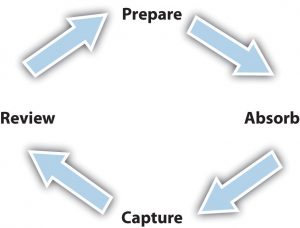11 Learning
The Learning Cycle
Four Steps to Learning
Adult learning is different from learning in primary and secondary school. In college, most of the responsibility for learning falls on the student. You’re free to fail — or succeed — as you choose. This applies as well to how well you learn. Learning an academic subject means really understanding it, being able to think about it in meaningful ways and to apply that understanding in new situations. This is very different from simply memorizing something and repeating it back on a test.
Academic learning occurs most effectively in a cycle of four steps:
- Prepare
- Absorb
- Capture
- Review

Prepare
Preparing to learn is the first step for learning. Partly, you are putting yourself in the right mind-set to learn.
Absorb
Absorbing refers to the actual taking in of new ideas, information, or experiences. This happens at the moment a student listens to a class lecture or reads a textbook.
Capture
Capturing refers to taking notes and other forms of documentation. Just hearing something once is seldom enough. You have to go back over the material again, sometimes several times again, thinking about it and seeing how it all fits together.
Review
The step of reviewing your class notes and other materials is the next step for solidifying your learning and reaching a real understanding of the topic. Reviewing is also the step in which you discover whether you really understand the material.
Reviewing is also a way to prepare for new information and ideas. That’s why this is a learning cycle: the end of the process loops back to the beginning as you prepare for additional learning.
Using your Memory

In your early and high school education, memorization was a key aspect of learning. You memorized multiplication tables, the names of the provinces, and vocabulary words. Memorized facts ensured your success on multiple-choice questions. In college, however, most of your work is focused on understanding the material in depth. Understanding themes and ideas and being able to think critically about them is really the key to your success in college learning. Although memorization is not the primary key to success, having a good memory is important to capture ideas in your mind, and it helps tremendously in certain subjects like sciences and foreign languages.
How Memory Works
Memory is the process of storing and retrieving information. There are two types of memory: short-term or active memory and long-term or passive memory.
Short-term Memory
Short-term or active memory is made up of the information we are processing at any given time. Short-term memory involves information being captured at the moment as well as from information retrieved from our passive memory for doing complex mental tasks, such as thinking critically and drawing conclusions. But short-term memory is limited and suffers from the passing of time and lack of use. We begin to forget data within thirty seconds of not using it, and interruptions, such as phone calls or distractions, require us to rebuild the short term memory structure—to get “back on task.” To keep information in our memory, we must either use it or place it into our long-term memory (much like saving a document on your computer).
Long-term Memory
Long-term memory is made up the information you know. How we save information to our long-term memory has a lot to do with our ability to retrieve it when we need it at a later date. Our mind “saves” information by creating a complex series of links to the data. The stronger the links, the easier it is to recall. You can strengthen these links by using the following strategies. You should note how closely they are tied to good listening and notetaking strategies.
Tips for moving information from short-term to long-term memory
- Make a deliberate decision to remember the specific data. “I need to remember Richard’s name” creates stronger links than just wishing you had a better memory for names.
- Link the information to your everyday life. Ask yourself, “Why is it important that I remember this material?”—and answer it.
- Link the information to other information you already have “stored,” especially the key themes of the course, and you will recall the data more easily. Ask yourself how this is related to other information you have. Look for ways to tie items together.
- Mentally group similar individual items into “buckets.” By doing this, you are creating links, for example, among terms to be memorized.
- Use visual imagery. Picture the concept vividly in your mind. Make those images big, bold, and colorful—even silly!
- Break information down into manageable “chunks.”
- Work from general information to the specific. People usually learn best when they get the big picture first, and then look at the details.
- Eliminate distractions.
- Test your memory often. Try to write down everything you know about a specific subject, from memory. Then go back and check your notes and textbook to see how you did.
Key Takeaways
- Learning at college goes beyond the memorization of facts; you are required to understand your subject materials so that you can think about it in meaningful ways and apply it to new situations.
- The academic learning cycle of preparing, absorbing, capturing and reviewing can help you better understand and use the information and skills presented in your courses.
- Short-term memory holds a limited amount of information that you process at one time, but it is temporary; long-term memory stores information by creating complex linkages that helps you recall important information at a later time. Moving information from short-term to long-term memory takes deliberate action on your part.

